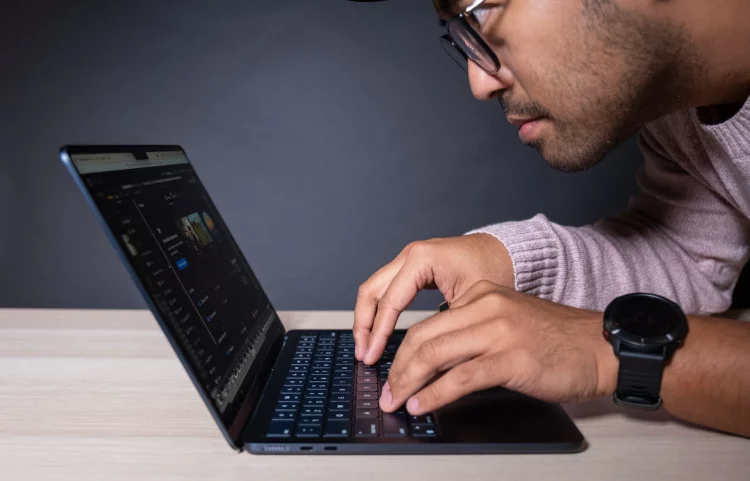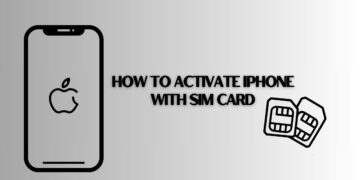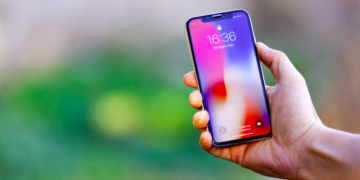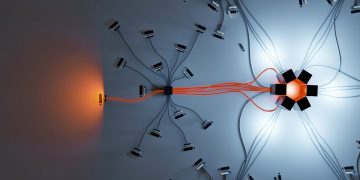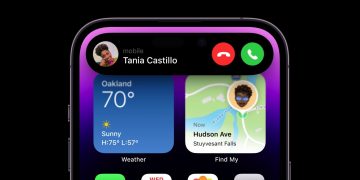Comment on this story
Comment
The new MacBook Air has a lot going for it: a new design, bigger screen, MagSafe charging, and a new Apple M2 chipset.
Among other things, Apple says that chipset includes a CPU (central processing unit) that’s 18 percent faster than the M1 chip you can still buy in a MacBook Air today. And that got us thinking: How likely is it that you’d actually be able to tell the difference?
To find out, we cooked up a little test: On a bright August morning, we set up the new M2 MacBook Air and the comparable M1 model from 2020 in such a way that I could use both of them without knowing which one was which. And despite my nerd bravado, even I couldn’t spot the difference consistently.
Here’s how it went and everything else you need to know about the new MacBook Air.
Is it really faster than the last one?
We embarked on a series of blind tests we thought represented what most people would probably need their computer for at some point.
First up: web browsing. I installed Chrome on both machines and jumped between the same 10-15 tabs while playing the same 4K YouTube videos in the background. They both seemed to handle the load equally well, though folks who like to keep dozens of tabs open would probably see either machine struggle. (Pro tip: When looking for any new computer, get the most RAM you can afford.)
Next on the list was video calls — with a twist.
Apps like Snap’s Snap Camera, which layers silly — and sometimes highly sophisticated — filters onto your face, can put a lot of strain on a machine. That can be especially true when you’re using it while you’re streaming or chatting in a Zoom call. Neither computer seemed to bat a proverbial eyelash when I went wild with the filters, and at one point I proclaimed that — based purely on the satisfying jiggle physics of my potato-face — I must be using the M2 model. I was wrong.
It wasn’t until we started editing videos that we really started to feel the difference between these two computers.
When it was time to export our 4K video clips at a much lower resolution, the M2 Air finished a few minutes ahead of last year’s model. That may not sound like much, but those moments add up quick when you’re working on bigger projects, or lots of projects back-to-back. Then again, if that’s the sort of thing you find yourself doing a lot of, you’d be better off with a MacBook Pro anyway.
Further testing — including of games like “Shadow of the Tomb Raider” and a slew of traditionally nitpicky benchmarks — confirm that the M2 Air is the higher-performing machine. It just takes extra work to see that speed in action — work that a lot of people might not notice immediately.
To folks who mainly rely on their computer for tasks such as web browsing and watching movies, the difference in chip may never feel apparent. If I just described you, a cheaper M1 Mac probably would suit you just fine.
If recommending last year’s model for some people feels a bit odd, it’s because Apple’s whole laptop lineup is a bit odd right now.
The Air is one of two new laptops that use Apple’s M2 processor, which (as we’ve seen) has some advantages compared to 2020’s M1 chip. But last year, Apple started building computers with different versions of the M1 — the M1 Pro and M1 Max — that actually outperform the M2.
You’d be forgiven for thinking the M2 was meant to set a new standard. Years of iPhone launches have drilled into us that the model with a new number is a bigger step forward than the model with the same number, plus a modifier. But despite what the new part number suggests, the M2 isn’t the fastest, best processor you’ll find in an Apple laptop; it’s just the newest.
Stranger still, the next step up from this MacBook Air is the M2 MacBook Pro — by all accounts it’s the faster machine, but because it still uses an old design, it doesn’t exactly feel like an upgrade.
Of course, no one ever buys a new laptop just for the chip inside of it. And in this case, the rest of the package is arguably just as important as the M2 itself.
- The screen. At 13.6 inches diagonal, this “Liquid Retina” display is the biggest screen Apple has ever crammed into an ultra-portable laptop. (That means it’s easier to squeeze even more stuff onto the display at once.) And while it isn’t as fancy as the screens found in last year’s updated MacBook Pros, this one is a little brighter than the one found in the previous model.
- An improved webcam. The previous MacBook Air had a notoriously lousy webcam, which stung even more because Apple released the laptop when people were getting used to sheltering in place because of the coronavirus. Thankfully, Apple bumped up the quality significantly this time around, meaning you won’t look like a blurry, pixely mess on your next Zoom call.
- Great battery life. Maybe the biggest benefit of Apple’s shift to its own processors is how much longer its laptops can run off a single charge. I’ve been able to use the M2 MacBook Air for upward of 10 hours during busy work days and still have enough power to last through the following morning. That’s a huge improvement compared with Apple’s older models — at its best, my last Intel MacBook Pro topped out at around seven hours — and it’s slightly better than the M1 model’s battery.
- The notch. It isn’t just weird to catch a glimpse of it throughout the day; it also takes up space in macOS’s menu bar that other apps sometimes use. And other laptop makers have nearly perfected the edge-to-edge screen look without having to rely on big camera cutouts.
- The new “Midnight” finish. Apple’s latest MacBook Air is available in a new dark blue finish called “Midnight,” which sounds fun and mysterious until you realize it picks up palm and fingerprints at the drop of a hat. (Apple pointed us to its cleaning support page, if this bothers you.)
- The higher starting price. The most basic M2 MacBook Air, with 8GB of RAM and 256GB of storage, starts at $1,199. That’s $200 more than the M1 MacBook Air — a laptop that’s still worth considering — costs today.
The M2 MacBook Air is a sleek, potent machine, and a great option if you haven’t upgraded your laptop in a few years. But if you mainly rely on your computer for web browsing, office/school work, and Netflix, the $999 M1 MacBook Air is more than enough and probably will be for a while.
So who should pay the $200 premium for the M2 model? Mainly, I’d say folks who want a better webcam and a nicer screen, though the extra horsepower tucked away here offers a little room to grow into if your needs change.
Source by www.washingtonpost.com






















